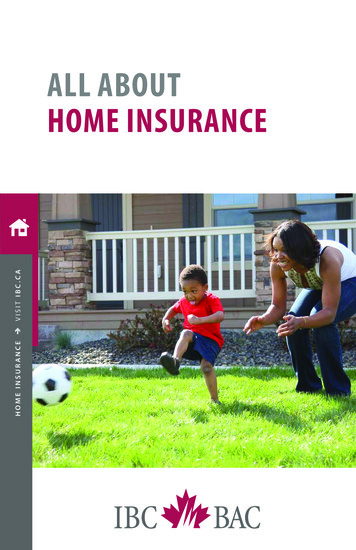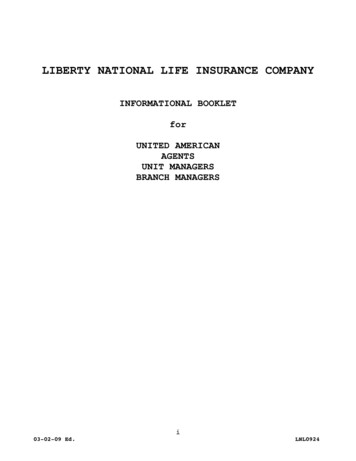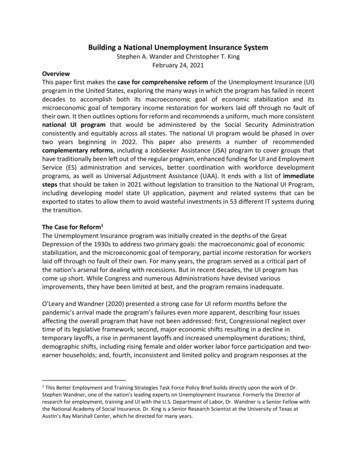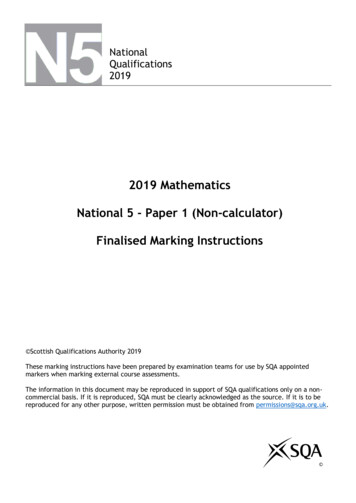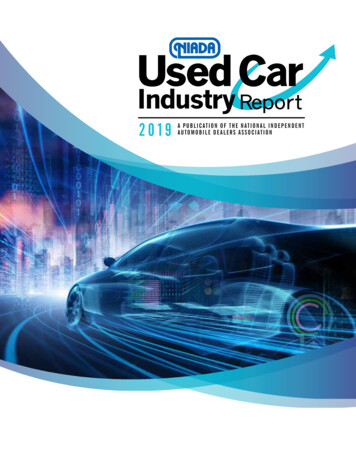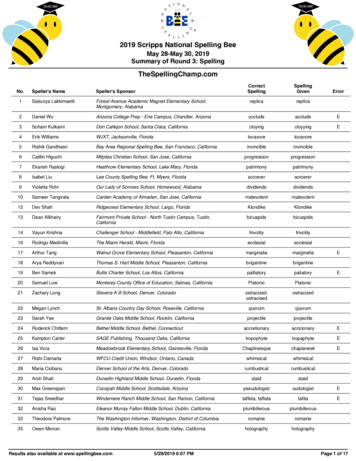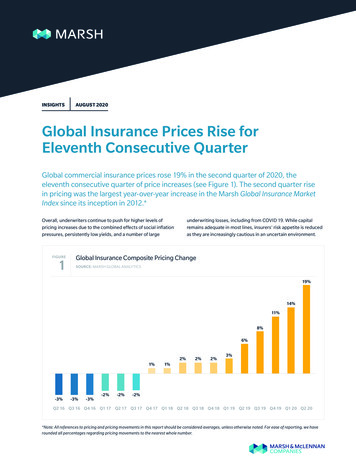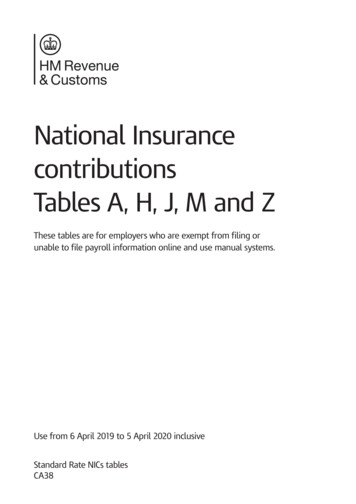
Transcription
National InsurancecontributionsTables A, H, J, M and ZThese tables are for employers who are exempt from filing orunable to file payroll information online and use manual systems.Use from 6 April 2019 to 5 April 2020 inclusiveStandard Rate NICs tablesCA38
Help and guidanceYou can get help and guidance from the following sources.The internetFor help with your payroll, go towww.gov.uk/business-tax/payeFor wider interactive business help, go towww.gov.uk/set-up-businessWebinarsWebinars are a way of learning about your payroll, such as‘Getting payroll information right’.This webinar covers the most common errors that employeesmake when submitting information to HMRC. It shows youhow to provide accurate data and avoid commonpayroll mistakes.For more information on this and other webinars, go ng-peopleAny page printed from the online version of this helpbookis uncontrolled and may not be the latest version.We recommend that you always check you’re referringto the latest online version.Online servicesFor information and help using our online services, go or more help with our online services,contact the helpline by: Telephone: 0300 200 3600 Textphone: 0300 200 3603Basic PAYE ToolsThe Basic PAYE Tools is software that you download ontoyour computer. It will help you run your payroll throughoutthe year. It’s designed for employers who have 9 or feweremployees, and you can use it to calculate payroll deductionsand then report payroll information online in real time.To find out more information about the Basic PAYE Toolsand other HMRC recognised software, go towww.gov.uk/payroll-softwareEmployer helplinesIf you’ve: been an employer for less than 3 years,Telephone: 0300 200 3211 been an employer for 3 years or more,Telephone: 0300 200 3200 a hearing or speech impairment,Textphone: 0300 200 3212Tell us your employer PAYE and Accounts Office referenceswhen you contact us. You’ll find them on correspondenceHMRC have sent to you.Employer helpbooks and formsHelpbooks and forms are available to download.Go to ons-for-employersYr laith GymraegI lawrlwytho ffurflenni a llyfrynnau cymorth Cymraeg, ewchi www.gov.uk/cymraeg sgroliwch i lawr i’r pennawd ‘Treth’ adilynwch y cysylltiadau ‘Ffurflenni Cyllid a Thollau EM (CThEM)’ac ‘Arweiniad a thaflenni gwybodaeth CThEM’.Forms and guidance in Braille,large print and audioFor details of employer forms andguidance in Braille, large print or audio,phone the Employer Orderline on0300 123 1074 and ask to speak tothe Customer Service Team.Help and support from the Digital Delivery TeamFind out more about our live and recorded webinars, go ng-peopleTo view our video clips, go to www.youtube.com/hmrcgovukFollow us on Twitter @HMRCbusiness:twitter.com/HMRCbusinessJoin our HMRC Online Customer ForumOur customer forum is for you and provides the help, supportand guidance you need. You can ask questions, see whatothers are asking and get the answers and top tips you needto support you in running your business.Employer Bulletin onlineEmployer Bulletins contain information and news for employers.We publish these 6 times a year. Go -customsemployer-bulletinEmployer email alertsWe strongly recommend that you register to receive employeremails to prompt and direct you to: each new edition or news about the Basic PAYE Tools the Employer Bulletin important new informationTo register, go to ubscriber/newDo you use PAYE Online?Remember to keep your email address up to date. If youchange your email address, update PAYE Online to make sureyou continue to receive email alerts when we’ve issuedtax codes and generic notifications.HM Revenue and CustomsIf you have a query about your PAYE scheme: phone the Employer Helpline on Telephone: 0300 200 3500 w rite toPT Operations North East EnglandHM Revenue and CustomsBX9 1BXUnited KingdomTell us your employer PAYE and Accounts Office referenceswhen you contact us. You’ll find them on correspondenceHMRC have sent to you.Your rights and obligations‘Your Charter’ explains what you can expect from us andwhat we expect from you. For more information, go towww.gov.uk/government/publications/your-charter
ContentsSave money – avoid errorsPage 2Which National Insurance contributions (NICs) tables to usePage 3Layout of these tablesPage 4Using these tables to work out NICsPage 5Earnings limits and NICs ratesPage 6An example of working out NICs using these tables and recording figures on form RT11Page 7A – Weekly table for standard rate NICsPage 8A – Monthly table for standard rate NICsPage 24H – Weekly table for standard rate NICs (employee under 25 apprentice)Page 42H – Monthly table for standard rate NICs (employee under 25 apprentice)Page 58J – Weekly table for NICs where employee has defermentPage 76J – Monthly table for NICs where employee has defermentPage 92M – Weekly table for standard rate NICs (employee under 21)Page 110M – Monthly table for standard rate NICs (employee under 21)Page 126Z – Weekly table for NICs where employee has deferment (employee under 21)Page 144Z – Monthly table for NICs where employee has deferment (employee under 21)Page 160Working out and recording NICs where employee’s total earnings exceed theUpper Earnings Limit (UEL)/Upper Secondary Threshold (UST)/Apprentice Upper Secondary Threshold (AUST)Page 178Additional gross pay tablePage 179Changes for the tax year 2019 to 2020At the time this booklet was printed, changes in the rates of NICs for the tax year 2019 to 2020 werestill subject to Parliamentary approval. Should Parliamentary approval not be obtained, we will informyou of any further changes before 6 April 2019.
Save money – avoid errorsDo it onlineWhat to do if your employee’s circumstances changeAlmost all employers are required to file their payrollinformation online. There are very few exceptions.For further information about these exceptions: go to -online-payroll-reporting go to the helpbook RT7, ‘Guidance for employersexempt from filing Real Time Information online’For more information about online filing,go to www.gov.uk/paye-onlineMake sure your staff know they must tell you,and HM Revenue and Customs National InsuranceContributions and Employer Office, of any changein circumstances. For example, change of address,change of name and particularly divorce if they paycategory B reduced rate NICs.Abolition of secondary NICs for those employeesunder the age of 21From April 2015 the rate of employer Class 1secondary NICs for employees under the age of 21 is0% up to the ‘Upper Secondary Threshold’ (UST).Checklist to help you submit your PAYE informationto HMRC1 The form RT11, (form RT11, ‘Deductions workingsheet’ replaces form P11 for the purposes ofoperating a manual payroll) must show ‘Tax yearstarting 6 April 2019’.2 Have you used the correct National Insurancecontributions (NICs) tables or percentage rates –are they for the current year?3 Do you hold a valid certificate (CA4139, CF383 orCF380A) for every married woman or widow forwhom you deduct category B reduced rate NICs?If not, deduct full rate NICs at category A, H or M.4 Have you any employees nearing State Pensionage? Check their date of birth before you decidewhich NIC category letter to use. Use category Cfor employees who are State Pension age or over,for whom you hold a copy of either their birthcertificate or passport as evidence of their dateof birth.Class 1 secondary NICs continue to be payable on allearnings above this threshold.The current way in which NICs is assessedremains unchanged.Employers should ensure that they hold theemployee’s correct date of birth.For more information go to CWG2 paragraph 3.8.5.Abolition of secondary NICs for Apprentices underthe age of 25From April 2016 the rate of secondary Class 1 NICsfor Apprentices under the age of 25 is 0% up to the‘Apprentice Upper Secondary Threshold’ (AUST).Apprentices must follow a government recognisedapprenticeship in the UK one which followsgovernment arrangements/approved frameworks, andhave a written agreement, specifying the governmentrecognised apprentice framework/standard, witha start and expected completion date. This is anagreement between the training provider, apprenticeand employer and is the evidence the employer needsto retain when applying the zero-rate of secondaryClass 1 NICs for an apprentice under 25.If you are an employer who is exempt fromfiling onlineWhen completing your payment submission, check: you have your employee’s full name, NationalInsurance number and, where known, address anddate of birth you have entered the correct category of NIC (foremployees who are aged 21 or over, this is usuallyeither A, B, C, H or J. For employees who areunder the age of 21, this is usually either M or Z.For Apprentices who are aged under 25, includingthose under 21, this is category H) that your addition is correct before entering theNIC amounts (both sides of RT11 added up andcarried forward)Secondary Class 1 NICs will continue to be payableon all earnings above the AUST.The current way in which NICs is assessedremains unchanged.Employers should ensure that they hold theemployee’s correct date of birth.For more information go to CWG2 paragraph 3.8.6.For more information on completing Real TimeInformation (RTI) forms go to helpbook RT7,‘Guidance for employers exempt from filing RealTime Information online’.Page 2
Save money – avoid errorscontinuedNational Insurance contributions (NICs)Employment AllowanceYou can claim the Employment Allowance as partof the normal payroll process through Real TimeInformation (RTI) or the Basic PAYE Tools.From 6 April 2014 you may be eligible to claiman Employment Allowance of up to 3,000.The Employment Allowance is available forbusinesses, charities (including community amateursports clubs) and certain employers of care andsupport workers to offset against employer’ssecondary Class 1 NICs liability.For more information, details of eligibility andhow to claim the Employment Allowance go toCWG2 paragraph 3.8.4 and go towww.gov.uk/claim-employment-allowanceWhich National Insurance contributions (NICs) tables to useNICs tables are renewed every tax year.Check you are using the tables for the tax year 2019 to 2020.If your employee is under 16 years of age, there is no NICs liability.You must use the correct tables when working out the NICs due on your employee’s earnings.Is your employeeState Pension ageor over?YesUse Table letter C(go to booklet CA41)NoDoes your employee have anotherjob where they already pay NICs onearnings at, or above, theUpper Earnings Limit and you holdform CA2700?NoIs your employee a marriedwoman or widow who is entitledto pay reduced rate NICs?YesUse Table letter B(go to booklet CA41)NoYesIs your employee anapprentice underage 25?Is your employeeunder the age of 21?YesUse Table letter Z(go to booklet CA38)YesUse Table letter H(go to booklet CA38)NoNoIs your employeeunder the age of 21?Use Table letter J(go to booklet CA38)YesUse Table letter M(go to booklet CA38)NoUse Table letter A(go to booklet CA38)If you employ mariners, booklet CA42, ‘National Insurance contributions for employers of foreign-goingmariners and deep sea fishermen’ gives details of category letters, rates and limits to use.Page 3
Class 1 secondary NICs for employeesunder 21 years of age (U21)A 0% rate of secondary NICs was introduced fromApril 2015 for employees under the age of 21, up tothe ‘Upper Secondary Threshold’ (UST). There is noreduction in the rate of Class 1 secondary NICs abovethe UST.For the tax year 2019 to 2020 this threshold is 962 weekly, 4,167 monthly, 50,000 annually.It is important to remember that this rate of secondaryNICs does not remove the role of the secondarycontributor. Employers are still required to fulfil anyother obligations associated with paying earnings,for example, administering statutory payments.These changes do not alter any of the rules forcalculating NICs other than by using the U21secondary rate where appropriate.Primary Class 1 NICs will remain unaltered.It is the responsibility of the employer to ensure theyuse and report the correct category letter. To do thisthey will need to hold the employee’s correct dateof birth.Class 1 secondary NICs forApprentices under 25 yearsof age (U25)A 0% rate of Class 1 secondary NICs was introducedfrom April 2016 for Apprentices under the age of 25,up to the ‘Apprentice Upper Secondary Threshold’(AUST). There is no reduction in the rate of Class 1secondary NICs above the AUST.For the tax year 2019 to 2020 this threshold is 962 weekly, 4,167 monthly, 50,000 annually.It is important to remember that this rate ofClass 1 secondary NICs does not remove the role ofthe secondary contributor. Employers are stillrequired to fulfil any other obligations associatedwith paying earnings, for example, administeringstatutory payments.These changes do not alter any of the rules forcalculating NIC’s other than by using the ApprenticeU25 secondary rate where appropriate.Primary Class 1 NIC’s will remain unaltered.It is the responsibility of the employer to ensure theyuse and report the correct category letter.Apprentices must follow a government recognisedapprenticeship in the UK i.e. one which followsgovernment arrangements/approved frameworks, andhave a written agreement, specifying the governmentrecognised apprentice framework/standard, witha start and expected completion date. This is anagreement between the training provider, apprenticeand employer and is the evidence the employer needs toretain when applying the zero-rate of secondaryClass 1 NICs for an apprentice under 25.Secondary Class 1 NICs will continue to be payable onall earnings above the AUST.Employers should ensure that they hold the employee’scorrect date of birth.For more information go to CWG2 paragraph 3.8.6.Apprenticeship LevyFrom April 2017 employers with annual pay billsgreater than 3 million, and some connectedcompanies and charities with pay bills less thanthis amount, will be required to pay theApprenticeship Levy.All employers (subject to the rules on connection) willhave an annual levy allowance of 15,000 with whichto offset against their levy liability. This means thatonly employers with a pay bill of over 3 million willhave to pay and report the levy. However, where theconnection rules apply, a pay bill less than 3 millionmay attract a levy liability, depending on how thelevy allowance is shared (connected companies andconnected charities only have a single 15,000 levyallowance for the group).The levy is charged at a rate of 0.5% of an employer’sannual pay bill. Pay bill is defined as earnings whichare liable to Class 1 secondary NICs, includingearnings below the Secondary Threshold.You will need to determine your levy liability. For moreinformation, go to CWG2 paragraph 3.8.7.Layout of these tablesThe first earnings figure in each table is the LowerEarnings Limit (LEL) ( 118 weekly or 512 monthly).This is because NICs liability only arises when theemployee’s total earnings in the earnings period reachthe LEL, even though no NICs are actually payable onthose earnings. The employer pays NICs only when theemployee’s earnings exceed the Secondary Threshold(ST) ( 166 weekly or 719 monthly). The employeepays NICs only when the employee’s earnings exceedthe Primary Threshold (PT) ( 166 weekly or 719monthly). But, for standard rate NICs, earningsbetween the LEL and the PT are used to protect theemployee’s entitlement to benefit.Page 4
Where there is a liability, the employee and theemployer pay NICs at the appropriate mainpercentage rate on earnings between the PT and STrespectively up to the Upper Earnings Limit (UEL)/Upper Secondary Threshold (UST)/Apprentice UpperSecondary Threhold (AUST).and with the exception of the LEL, PT, ST, UEL, USTand AUST is worked out at the mid-point of the steps.Therefore, you and your employee may pay slightlymore or less than if you used the exact percentagemethod to work out the NICs due.Where the employee’s total earnings fall between theLEL and the UEL/UST/AUST, if the exact figure is notshown in the tables, use the next smaller figure shown.The last earnings figure in each table is theUEL/UST/AUST ( 962 weekly or 4,167 monthly).This is because employee’s NICs are due only at a rateof 2% on earnings above the UEL/UST/AUST. Theemployer pays NICs at the rate of 13.8% on earningsabove the UEL/UST/AUST.Where the employee’s total earnings exceed theUEL/UST/AUST, go to page 163.For instructions on how to complete form RT11or equivalent, go to helpbook RT7, ‘Guidance foremployers exempt from filing Real TimeInformation online’.The figures in the left-hand column of each tableshow steps between the LEL and the UEL/UST/AUST. The NICs liability for each step is based on theearnings limits and percentage rates shown on page 6An example form RT11 is also shown on page 7.Using these tables to work out National Insurance contributions (NICs)IntroductionIdentifying the correct table to useThese tables are aimed at the small number ofemployers that are exempt from filing payrollinformation online and the guidance on how torecord the figures that are displayed within the tablesis for employers who are operating a manual payroll.Table letter AForm RT11, ‘Deductions working sheet’ replaces formP11 for the purposes of operating a manual payroll.Table letter HUse this table for all employees aged 21 or over andunder State Pension age and Apprentices who areaged over 25.Use this table for all Apprentices who are under theage of 25 and are following a government approvedframework.You can work out NICs by using either: these tables the exact percentage methodTable letter JUse this table for all employees who are aged 21 orover, for whom you hold form CA2700 allowingthem to defer payment of employee’s NICs at the fullmain percentage rate.For general information about NICs, go to theemployer helpbooks.Are you using the correct tables?Only use these tables between 6 April 2019 and5 April 2020 (the tax year 2019 to 2020).Table letter MUse this table for all employees who are under the ageof 21 and are not apprentices following a governmentapproved framework.Only use the tables in this booklet for employees whoare employed in the tax year 2019 to 2020, and forwhom NICs are payable under table letter A, H, J,M or Z.Table letter ZUse this table for all employees who are under theage of 21 for whom you hold form CA2700 allowingthem to defer payment of employee’s NICs at the fullmain percentage rate.If there is no table in this booklet for aparticular employee, you must use a table froma different booklet.About these tablesThe tables under letters A, H, J, M or Z contain 2tables, for: weekly pay intervals monthly pay intervalsThe letters A, H, J, M or Z correspond with the tableletters under which NICs are payable.Page 5
How to use these tablesAdapting these tables for pay intervals other thanweekly or monthly1 Decide which table you should use, A, H, J, M orZ and then apply the earnings period (weekly ormonthly) to determine the NICs liability.2 Look up the employee’s gross pay in the left-handcolumn of the table. If the employee’s totalearnings fall between the LEL and the UEL/UST/AUST and the exact amount is not shown, use thelower amount closest to the exact gross pay. If theemployee’s total earnings exceed the UEL/UST/AUST, go to page 163.3 Record the figures in each column of the table ontothe employee’s form RT11, ‘Deductions workingsheet’. Go to the example on page 7.If the employee is paid in multiples of a weekor month: divide the pay into equal weekly or monthlyamounts to get an average weekly ormonthly amount
National Insurance contributions Tables A, H, J, M and Z These tables are for employers who are exempt from filing or unable to file payroll information online and use manual systems.File Size: 1MB
